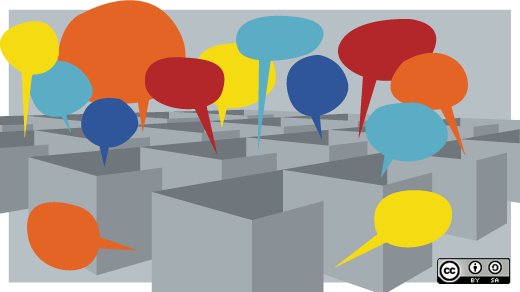STEMM Role Models is a website that helps connect event organizers with presenters from underrepresented groups. Diversity is important to me, so the project caught my eye.
I reached out to project lead Kirstie Whitaker, a postdoctoral scientist at the University of Cambridge, to learn more. She graciously agreed to an interview, and what follows is a fascinating look at the STEMM Role Models project and its implications for open science, open source, and the future of humanity.

Tell us about yourself. What attracted you to open source?
I'm a member of the brain mapping unit in the department of psychiatry and I study child and adolescent brain development. I'm particularly interested in how early life experiences can affect the timing of brain maturation and how this can affect risk of mental health disorders.
I studied physics for my undergraduate and master's degrees, and it was during my PhD in neuroscience that I started using functional and structural magnetic resonance imaging (MRI) to understand how we think and learn. As you might imagine, the statistical methods are really complicated and there are so many different ways to carry out the research. Open source software not only allowed me to try out all these different methods and techniques for free, but also let me truly understand exactly what I was doing! I'm a better scientist for being able to see under the hood.
You call yourself an open science advocate. Why is open science important?
At the moment, scientists are rewarded for keeping secrets. They're awarded grants based on being better than others, and their research is considered more prestigious if they are the first and only group investigating the question. Open science brings us back to what I consider to be the true goal of scientific research: to understand the world through a process of rigorous investigation.
Open science advocates for transparency in research rather than selective publication of cool and sexy results. It mandates sharing of analysis code so others can both verify your work and use it in their own studies, and it promotes creativity through sharing data so that others can use it to answer questions you may not have considered. We are so much more powerful working together than apart. Humanity benefits from scientists working together rather than in competition.
I read on your website that you are "a passionate advocate for replicability and reproducibility in academic work and for the diversification of researchers in science." How has open science facilitated that?
I use open and freely available tools to conduct my analyses and I share all the code online. This means that anyone who wants to understand my work can both check it and use it themselves. If they have data that's very similar to mine but from a different cohort of human subjects, they can replicate the work to check that any effects I find are generalizable. Without replicating studies we can not widely apply our knowledge! We can only say something about the 20 people who participated in our experiment.
Looking forward, we need to enhance diversity in scientific leadership to ensure we continue to innovate. The pattern of having most positions of authority held by cis-gendered, straight, white men leads us down a very narrow path. For example, historically all studies using animal models have excluded females due to their regular hormonal fluctuations. This means that a factor such as sex has not been systematically investigated for a huge range of diseases, including ones that primarily affect women. It was only in 2014 that that National Institutes of Health mandated that all federally funded research would have to investigate both sexes.
By including the voices and opinions of women, people of color, people with disabilities, and members of the LGBTQ community, we can ensure that we pioneer across all fields. Open science makes it easier to break into the traditionally male-dominated halls of the ivory tower and support each other in our quest to answer the most exciting questions across all scientific disciplines.
Tell us more about STEMM Role Models. How is this project open source? How does open source empower involvement with this project?
In February of this year, the STEMM Role Models team won the runner-up prize in the Rosalind Franklin Appathon, a national competition to find the best ideas to harness the power of mobile technology to support women in Science, Technology, Engineering, Math, and Medicine (STEMM).
We sought to tackle the problem that women are less likely to be invited to speak at conferences, even when you take into account their lower representation in senior positions as a whole. We know the confidence that young researchers build when they see people "just like them" in leadership roles, and we know that increasing diversity can inspire the most creative ideas across all fields of STEMM and at every step along the academic career trajectory.
We proposed a database that conference organizers could use to widen their reach when considering which researchers to invite to speak or to sit on panels. Each profile contains information about the researcher's skills, publications, previous speaking engagements, etc., as well as their membership in some of the typically underrepresented groups in leadership positions in STEMM: women, people of color, people with disabilities, LGBTQ, and parents or carers.
Two important aspects set the STEMM Role Models project apart from current tools (such as Google) that can be used to create speaker lists:
- Anyone can add people to the database (department administrators, principal investigators, funding agencies), thus minimizing the effects of impostor syndrome, which causes women to promote themselves less than men.
- We will curate testimonials from members of the community who have seen the women speak, which helps conference organizers build the very best program they can.
We are dedicated to open source development and providing opportunities for women and other underrepresented groups to build their confidence working in an online collaborative environment. We welcome anyone of any level of experience and at any career stage (including our friends outside the ivory tower of academia!) to join us in our adventure of building the website and associated mobile app.
We're looking for help with front and back-end development, fundraising, and communication with various communities to ensure our tool is useful and relevant to their needs. Check out our guide for contributors on our GitHub repository for more information.
How does diversity strengthen open science?
It can be very intimidating to join an open source development community. There is an awful lot of technical jargon and even more opinions on the best way forward. The atmosphere can feel very stereotypically masculine and discourage women and other underrepresented groups from joining in. They have an added cognitive load of combating stereotype threat when joining the community that makes it much more exhausting than if all the members look just like you!
By ensuring that everyone feels welcome, having a well defined code of conduct (and enforcing it if need be), and providing clear instructions on how to get involved, you harness a much larger pool of talent! And if your developers represent your target audience by having a broad range of interests, skills, background knowledge, and application goals, your software will be more widely used and more actively improved upon.
How does STEMM Role Models transform science on the web?
Although there are exceptional resources and workspaces on the web, in-person interactions are still the foundation of many scientific collaborations. By promoting underrepresented groups to conference organizers, we're raising their profile and more widely sharing their work with others. We're opening up a plethora of previously untapped possibilities for international and interdisciplinary collaborations. We're harnessing the power of the whole scientific community, rather than the same old faces.







Comments are closed.